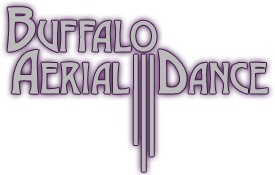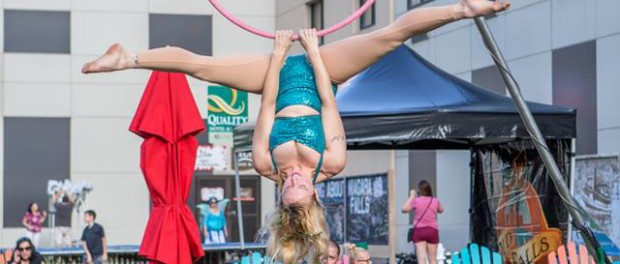Your Handy Guide to Becoming a Super Aerialist
As more and more people become interested in aerial arts, there is much excitement and also much confusion about the training process. Here are a few things I’ve found myself explaining again and again:
1. Yes, you can do it!
It wasn’t until the last decade that aerial arts became generally available as a recreational activity. Prior to that, circus arts were guarded secrets handed down through generations of performers who depended on the uniqueness of their skills for their livelihood. There are many fantastic feats performed in the circus that most of us will never do, but many people are surprised to find there are plenty of skills that are rather accessible.
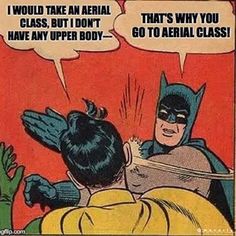
A favorite meme of aerial instructors everywhere.
I’ve seen a lot of people delighted to discover that they can in fact do a beginner aerial class, reassured by the fact that we start just a foot or two off the ground with basic poses. However I’ve seen others frustrated by those same circumstances, expecting to be twirling high in the air right away. Most of what we see of circus arts on TV or social media is highlight reels of high level performers. The awkward beginner stages are a lot less visible, but we’re all beginners at some point, and you only get to be a beginner once, so enjoy it in all of its awkward glory!
2. People come into class with a huge range of different experiences
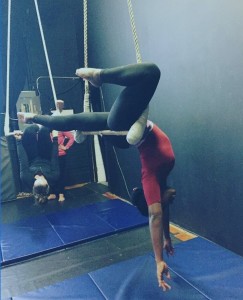
The Lovely Courtney Barrow demonstrating a Gazelle pose on trapeze. Some people get this move right away; it took yours truly 3 months to let go of the bar.
In any field there are people who have certain advantages. Twenty years of gymnastics training would be great benefit to have in aerial work, and some come into the studio with such training; some have had the complete opposite life experience and are wondering what they’re getting themselves into. Aerial arts can be fabulous for the veteran gymnasts and the apprehensive- yet-curious types alike, as well as everyone in between. However, it can be so very tempting to compare yourself to others and beat yourself up for not being able to that crazy trick that she is doing. First of all, don’t worry so much about what she’s doing! Second of all, I guarantee she wasn’t born that way; she had to work for it at some point, just like you are doing now.
3. What you do outside of class matters, and there will be fluctuations
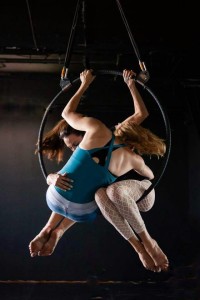
Some days spinning is a great idea; other days not so much
Realistically you’re in aerial class for maybe 2, up to 5-6 hours a week, out of about 100+ hours of other stuff, plus some sleep time. You’re doing things that affect your body that WHOLE TIME, not just those few hours. One of the most frustrating things is that after 10 years of training, if I go to bed late a couple nights, eat too much junk food, or get a cold, more often than not, the next day or two, I can’t do some of the tricks that I’ve done for years. And I totally internally freak out that I’ll never do cool aerial moves ever again. But then I calm myself down and recognize that being a human in a human body means that body is different on different days.
I love aerial work for making me aware of how my body feels on a daily basis in a way that I never much noticed before, and how it motivates me to go to eat less junk food and get more sleep because I want to feel my best when I train. I take time each day to check in with how my muscles feel, how I’m breathing and moving. Aerial arts is often very strenuous and you might feel your muscles getting tight, or you might feel more energized or more tired than before. Sometimes we are over eager, trying to get into a certain position and we stretch a little too far; sometimes we are held back by our fears and realize we could’ve pushed a little harder; and sometimes, something else entirely has made your body feel differently. Try to connect the feedback loop of how your body feels with your training and your other activities, both to help you improve and to avoid injuries. It’s a ritual I try to share in my warmups to give students a sense of overall body awareness.
4. Don’t be a YouTubian aerialist

” I saw it on YouTube” (This is Isabelle Chasse in 1996 in Quidam, credited as first widely-known silks performance in Cirque du Soliel.)
Most schools strongly discourage learning tricks from the internet for a whole variety of reasons. For some articles on those very good reasons, check out the following: Can I do Aerial in my Living Room? and How Not to Learn Circus from YouTube. Nevertheless we live in the midst of a giant social media soup, and it’s almost impossible not to take a few sips. Be aware that the soup varies greatly in quality. And picking only videos of high quality doesn’t solve the problem. There are many very very skilled performers who make very very difficult moves appear easy. Grace and ease is the ultimate illusion that aerialists seek to create – appreciate it as a skillful illusion and do not trust it. Otherwise, at best, you’ll waste a lot of time training ineffectively and be incredibly frustrated by trying moves that are beyond you skill level; at worst, you’ll risk severe injury. Yikes.
There are some instances where learning from online videos and tutorials can serve to supplement in-studio training, but only after you’ve built a solid foundation with a live instructor, someone who can see you in action and help you build skills in an organized and effective manner. If you’re thirsting for those fancy moves you’ve seen your aerial idols doing, consider that most studios will have classes organized in skill progressions to give a sense of what the path to fanciness looks like. Feel free to ask the instructors about the moves that caught your eye, but be prepared for them to tell you it takes time and effort. Also, you will get way more respect from other aerialists if you learn from real live trained instructors, because we care about our artform!
5. Different goals for different souls
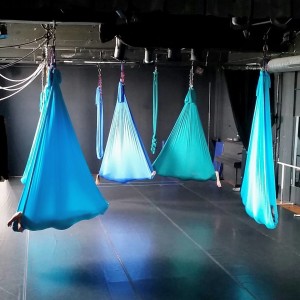
Maybe my #goals are to get in comfy hammock and take a nap.
Aerial arts has become so widely popular because it’s not only tons of fun, but also a very versatile activity. Some people are really into the therapeutic benefits of hanging upside down and that is plenty. Some people are excited to be 2 feet off the ground and challenged by the goal of using their strength to stay on cool circus equipment. Playfulness and the appeal of a creative outlet attracts many dancers and performers to aerial arts. Others long to learn how to become graceful flying swans or dynamic circus artists. Most of us are on their own journey of self-improvement and discovering it as they go along. We all train differently.
6. Learning aerial skills isn’t necessarily about getting in shape
Well, it could be, but there are some major misconceptions to clear up. It depends on both what your expectation of “aerial arts” is and what your expectation of “in shape” is. Aerial arts can be anything from sitting and posing on an apparatus (not burning many calories, but sure is fun) to performing dynamic release moves (surely burning calories and is super fun, but also super hard). If you envisioned yourself twirling dramatically from the ceiling as a super fun way to workout, you might be in for a surprise: there’s a long road to get to that and some of it is just straight up hard work. There are plenty of times when practicing aerial is really so much fun that you forget you’re working out, but there are certainly times when you’re far from forgetting that too.
The getting in shape part of aerial work involves a lot of a little thing we call conditioning. Some conditioning uses the aerial apparatuses much like you’d use a TRX or gym equipment, and some happens on the ground or against the wall, similar to Pilates work. It’s a lot of strength building drills, meaning a lot of repetitions, and it happens at every level along the way. If that’s something that you’re willing to do, and perhaps can even get excited about, well then you’re in luck, aerial arts could just be your ticket to getting in shape. And a lot of conditioning moves can safely be done at home and/or using online tutorials (or take some Pilates classes).
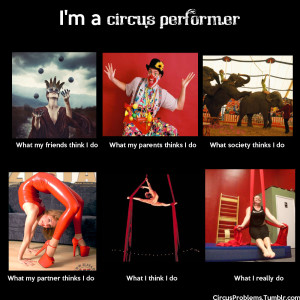
Conditioning is where it’s at.
However, even if conditioning doesn’t sound like your kind of picnic, our Level 1 skills are still accessible to most people, and beginner classes can be a great way to get moving just for the fun of it. Also keep in mind that aerial arts alone may not give you the fitness level you want, but it’s a great motivator for exercising more often! It’s a lot more fun to work out when you’re inspired by those fancy twirly moves, and you feel your body getting stronger each time you get on the aerial apparatuses.
